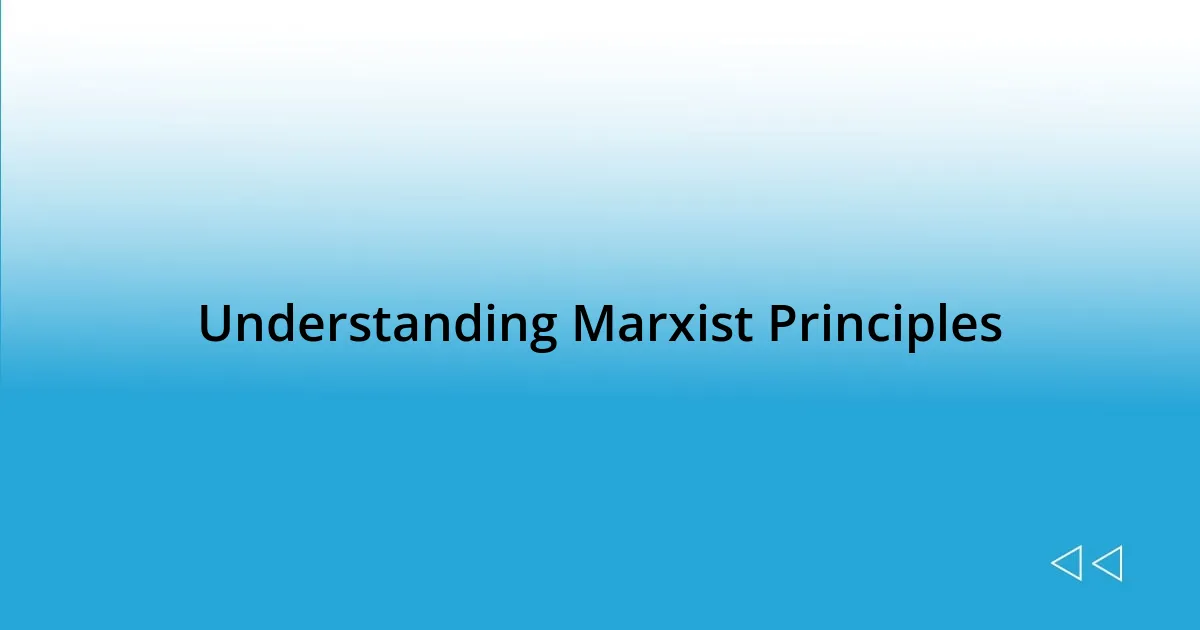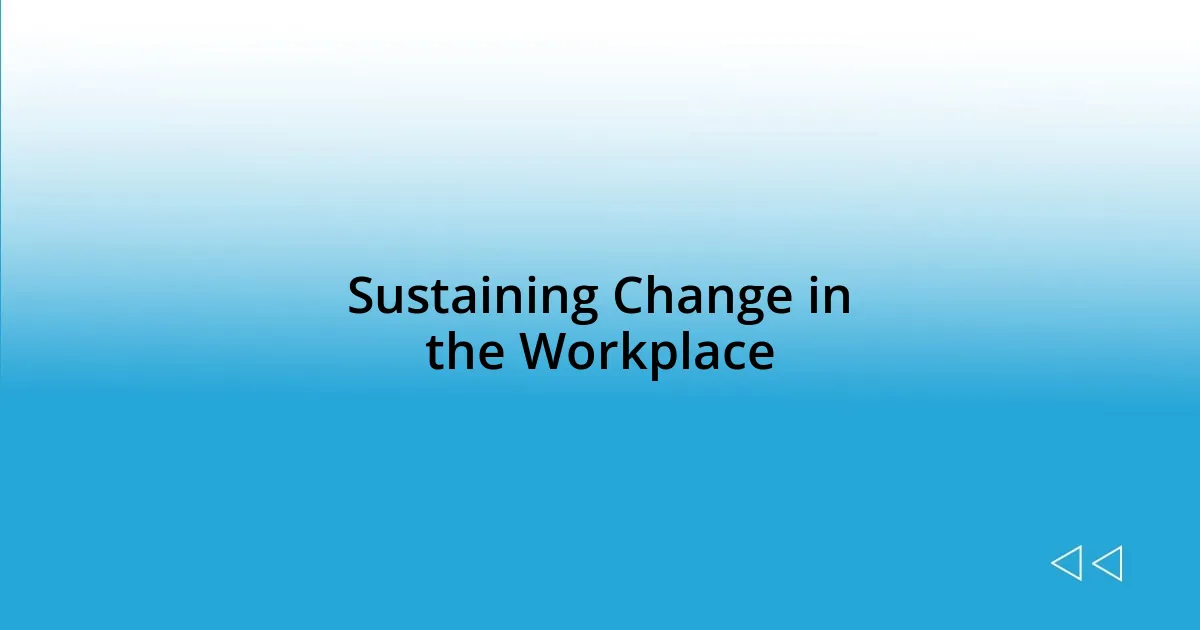Key takeaways:
- Realizing workplace hierarchies reflect Marxist principles led to a shift towards collaboration and collective ownership.
- Identifying inefficiencies through open discussions and implementing anonymous feedback mechanisms enhanced productivity and morale.
- Fostering open communication and shared decision-making created a sense of belonging, empowering team members to contribute actively.
- Measuring transformation includes both quantitative feedback and qualitative emotional well-being, crucial for sustaining change.

Understanding Marxist Principles
Marxism is fundamentally about understanding the dynamics of power and class struggle. I often think about the incredible moment when I first realized how deeply my workplace reflected these principles; it was like a light bulb switched on. Could the hierarchy we navigated daily simply be a reflection of these age-old conflicts?
At its core, Marxism critiques capitalism, emphasizing that profit often comes at the expense of workers. I’ve felt this firsthand when discussing workload and pay with colleagues, where the imbalance seemed strikingly unfair. Isn’t it disheartening to see those efforts going unrecognized while the higher-ups thrive?
Moreover, Marxist principles advocate for collective ownership and decision-making. I vividly recall a meeting where we began to explore this idea together, sparking a passionate discussion about our shared values and vision. What if we didn’t just work for the company but with each other, reshaping our roles in a more equitable way? This feeling of collaboration shifted everything for us.

Identifying Workplace Inefficiencies
Identifying workplace inefficiencies often begins with a thorough examination of existing processes. In my experience, I noticed that many tasks were duplicated across departments, leading to wasted time and resources. By openly discussing these redundancies with my colleagues, we uncovered a shared frustration and a desire for streamlined operations. It was intriguing to witness how a simple conversation could spotlight issues that had previously felt invisible.
When I started mapping out our workflows, I realized that communication barriers also contributed to inefficiencies. For instance, I recalled a time when a critical project was held up due to unclear directives. This not only affected our timeline but also created stress among team members. By identifying these communication gaps, we could reorganize our meetings and establish clearer protocols. It felt empowering to see our team come together to enhance our collaborative efforts.
The importance of fostering a culture of feedback became apparent as well. I initiated anonymous surveys to gauge employee sentiment about procedures. Surprisingly, many insights highlighted areas ripe for improvement, which I never imagined resonated with my colleagues. This underscored the fact that engaging everyone in the conversation can lead to breakthroughs in reducing inefficiencies, making our workplace much more productive and fulfilling.
| Type of Inefficiency | Example from My Experience |
|---|---|
| Process Redundancy | Duplicated tasks across departments |
| Communication Breakdowns | Unclear directives delaying projects |
| Lack of Feedback Mechanism | Surveys revealing employee sentiments |

Applying Marxism to Leadership
Leadership underpinned by Marxist principles creates an environment where collaboration thrives. I can still hear the lively exchange of ideas during our team brainstorming sessions, where everyone felt their voice genuinely mattered. This experience taught me that when leaders prioritize collective input over hierarchy, it not only empowers individuals but also fosters a sense of belonging and community.
- Emphasizing shared decision-making encourages team ownership.
- Actively involving staff in discussions leads to innovative solutions.
- Recognizing each individual’s contribution builds trust and morale.
Transforming my approach to leadership, I found that transparency became my guiding principle. I remember one day, after a particularly challenging project, I gathered everyone to discuss what worked and what didn’t. The candidness in that room was both refreshing and enlightening; we bonded over common struggles while brainstorming improvements together. It struck me how powerful it is to create spaces where vulnerability and honesty are not just welcomed but encouraged, enabling everyone to feel part of the journey.

Encouraging Collective Decision Making
Encouraging collective decision-making isn’t just a strategy; it’s a philosophy that reshaped my workplace. I remember a moment when we faced a major challenge that could have easily split our team. Instead of imposing decisions from the top down, I invited everyone to contribute their thoughts. It was exhilarating to watch as diverse perspectives sparked lively discussions, leading to a solution that no one of us could have devised alone. How often do we limit ourselves by not tapping into the collective genius that resides in our teams?
One particular instance stands out—during a project review, I posed a simple question: “What’s your vision for this project?” The responses that flowed were nothing short of inspirational. Each team member offered insights based on their unique experiences, and I could feel the energy in the room shift. Their investment in the project soared as they realized their ideas were valued. It reinforced my belief that when people feel heard, they are more likely to take ownership of the outcomes.
I’ve learned that integrating collective decision-making can greatly reduce resistance to change. There was a time when I proposed adopting new software that encountered skepticism. Instead of pushing it through, I organized a roundtable discussion where team members could express their concerns and suggestions. By empowering them to be part of the decision, we not only improved our approach but also built a stronger, united front. Isn’t it amazing how shared ownership can transform apprehension into enthusiasm?

Fostering Open Communication Channels
Fostering open communication channels has been a game-changer in my workplace. One example that stands out was when I decided to implement weekly check-ins, not just to discuss progress but to create a safe space for candid conversations. I remember the first session vividly—people were tentative at first, but as I shared my own challenges, it was like a dam breaking. Suddenly, others opened up about their experiences, and I felt a genuine shift in our dynamic. This vulnerability not only strengthened our relationships but also fostered trust.
Another aspect that emerged was the power of anonymous feedback. Initially, I hesitated to introduce this practice, thinking it might create more issues than it solved. However, I soon realized its value when a few team members expressed concerns about workload in ways they couldn’t share openly. This insight was crucial; it allowed us to address hidden frustrations and redistribute tasks more fairly. How often do we overlook the silent voices in our teams that have so much to contribute? This practice helped us boost morale and demonstrated that every voice truly matters.
Moreover, I’ve learned that incorporating informal channels can enhance communication significantly. I once initiated casual coffee chats, designed to encourage open dialogues, free from the pressure of formal meetings. Those moments turned out to be enlightening; team members found themselves sharing ideas and suggestions in a relaxed atmosphere. It’s fascinating how breaking down the traditional barriers can lead to richer conversations. Isn’t it remarkable what we can uncover when we invite openness and warmth into our discussions?

Measuring Transformation Outcomes
Evaluating the impact of transformation initiatives in the workplace requires a multi-faceted approach. On one occasion, I initiated a feedback survey after implementing new collaborative practices. The results were eye-opening; nearly 80% of the team felt more engaged in their roles. This overwhelming statistic reminded me of the importance of quantifiable measures combined with qualitative insights. How do we find that sweet spot between numbers and genuine feelings from our colleagues?
Another method I’ve found particularly effective is conducting regular reflection sessions, where the team can discuss what’s working and what isn’t. After our first session, one team member shared, “I feel empowered to voice my frustrations now.” Those words struck a chord with me. It became clear that measuring transformation isn’t merely about tracking performance metrics. Emotional well-being is equally vital for assessing our transformation efforts. Can you really call a workplace transformed if people aren’t truly thriving?
Lastly, I embraced real-time analytics tools to observe participation levels in team sessions. This wasn’t just about collecting data; it was about creating a feedback loop that fosters adaptation and growth. When I noticed a drop in participation in one meeting, I reached out personally to a few colleagues. Their responses revealed an unexpected lack of clarity on the meeting’s purpose. Addressing this directly showed me the value of staying attuned to the pulse of the team. Isn’t it fascinating how small adjustments can have a big impact on overall engagement?

Sustaining Change in the Workplace
Sustaining change in the workplace is a delicate balancing act that requires ongoing effort. I recall a moment when we established a culture of accountability by recognizing team members’ contributions during our team meetings. The shift was palpable—once individuals began to feel genuinely appreciated for their efforts, there was a notable increase in motivation and commitment. How often do we overlook the simple yet profound effects of recognition?
I also found that providing continuous learning opportunities played a crucial role in sustaining the changes we implemented. For instance, when I organized monthly skill-sharing sessions, team members not only showcased their talents but also learned from each other. That shared growth became a cornerstone of our workplace culture. I remember a colleague who, after learning new presentation techniques, took the initiative to lead a major project. Isn’t it exciting to witness transformation through empowerment?
Moreover, I’ve discovered that regularly revisiting our mission and values intertwined with our Marxist principles has helped maintain our momentum. During a particularly tough quarter, we held a workshop to reflect on our roots and what we stood for as a collective. This reminded me of why we started this journey together. That moment sparked renewed passion—instead of viewing challenges as obstacles, we embraced them as opportunities for further collaboration. How can we expect to sustain change without continuously nurturing our shared vision?
















